Cortical Reorganization of Early Somatosensory Processing in Hemiparetic Stroke
Abstract
1. Introduction
2. Materials and Methods
3. Results
4. Discussion
Author Contributions
Funding
Institutional Review Board Statement
Informed Consent Statement
Data Availability Statement
Acknowledgments
Conflicts of Interest
References
- Virani, S.S.; Alonso, A.; Benjamin, E.J.; Bittencourt, M.S.; Callaway, C.W.; Carson, A.P.; Chamberlain, A.M.; Chang, A.R.; Cheng, S.; Delling, F.N.; et al. Heart disease and stroke statistics—2020 update: A report from the American Heart Association. Circulation 2020, 141, E139–E596. [Google Scholar] [CrossRef] [PubMed]
- Lo, A.C.; Guarino, P.D.; Richards, L.G.; Haselkorn, J.K.; Wittenberg, G.F.; Federman, D.G.; Ringer, R.J.; Wagner, T.H.; Krebs, H.I.; Volpe, B.T.; et al. Robot-assisted therapy for long-term upper-limb impairment after stroke. N. Engl. J. Med. 2010, 362, 1772–1783. [Google Scholar] [CrossRef] [PubMed]
- Millán, J.D.R.; Rupp, R.; Mueller-Putz, G.; Murray-Smith, R.; Giugliemma, C.; Tangermann, M.; Vidaurre, C.; Cincotti, F.; Kubler, A.; Leeb, R.; et al. Combining brain–computer interfaces and assistive technologies: State-of-the-art and challenges. Front. Neurosci. 2010, 4, 161. [Google Scholar] [CrossRef]
- Pollock, A.; Farmer, S.E.; Brady, M.C.; Langhorne, P.; Mead, G.E.; Mehrholz, J.; Van Wijck, F. Interventions for improving upper limb function after stroke. Cochrane Database Syst. Rev. 2014, 11, CD010820. [Google Scholar] [CrossRef] [PubMed]
- Veerbeek, J.M.; Langbroek-Amersfoort, A.C.; Van Wegen, E.E.; Meskers, C.G.; Kwakkel, G. Effects of robot-assisted therapy for the upper limb after stroke: A systematic review and meta-analysis. Neurorehabilit. Neural Repair 2017, 31, 107–121. [Google Scholar] [CrossRef]
- Grefkes, C.; Fink, G.R. Reorganization of cerebral networks after stroke: New insights from neuroimaging with connectivity approaches. Brain 2011, 134, 1264–1276. [Google Scholar] [CrossRef]
- McPherson, J.G.; Chen, A.; Ellis, M.; Yao, J.; Heckman, C.; Dewald, J.P.A. Progressive recruitment of contralesional cortico-reticulospinal pathways drives motor impairment post stroke. J. Physiol. 2018, 596, 1211–1225. [Google Scholar] [CrossRef]
- Wilkins, K.B.; Owen, M.; Ingo, C.; Carmona, C.; Dewald, J.P.A.; Yao, J. Neural Plasticity in Moderate to Severe Chronic Stroke Following a Device-Assisted Task-Specific Arm/Hand Intervention. Front. Neurol. 2017, 8, 284. [Google Scholar] [CrossRef]
- Ellis, M.D.; Drogos, J.; Carmona, C.; Keller, T.; Dewald, J.P.A. Neck rotation modulates flexion synergy torques, indicating an ipsilateral reticulospinal source for impairment in stroke. J. Neurophysiol. 2012, 108, 3096–3104. [Google Scholar] [CrossRef]
- Li, S.; Chen, Y.-T.; Francisco, G.E.; Zhou, P.; Rymer, W.Z. A Unifying Pathophysiological Account for Post-stroke Spasticity and Disordered Motor Control. Front. Neurol. 2019, 10, 468. [Google Scholar]
- Owen, M.; Ingo, C.; Dewald, J.P.A. Upper Extremity Motor Impairments and Microstructural Changes in Bulbospinal Pathways in Chronic Hemiparetic Stroke. Front. Neurol. 2017, 8, 257. [Google Scholar] [CrossRef] [PubMed]
- Tian, R.; Dewald, J.P.A.; Yang, Y. Assessing the Usage of Indirect Motor Pathways Following a Hemiparetic Stroke. IEEE Trans. Neural. Syst. Rehabil. Eng. 2021, 29, 1568–1572. [Google Scholar] [CrossRef] [PubMed]
- Yang, Y.; Sinha, N.; Tian, R.; Gurari, N.; Drogos, J.M.; Dewald, J.P.A. Quantifying Altered Neural Connectivity of the Stretch Reflex in Chronic Hemiparetic Stroke. IEEE Trans. Neural. Syst. Rehabil. Eng. 2020, 28, 1436–1441. [Google Scholar] [CrossRef]
- Brunnstrom, S. Movement Therapy in Hemiplegia: A Neurophysiological Approach; Harper & Row: New York, NY, USA, 1970; pp. 113–122. [Google Scholar]
- Li, S.; Francisco, G.E.; Rymer, W.Z. A New Definition of Poststroke Spasticity and the Interference of Spasticity with Motor Recovery from Acute to Chronic Stages. Neurorehabilit. Neural Repair 2021, 35, 601–610. [Google Scholar] [CrossRef] [PubMed]
- McPherson, J.G.; Stienen, A.H.; Drogos, J.M.; Dewald, J.P. Modification of Spastic Stretch Reflexes at the Elbow by Flexion Synergy Expression in Individuals With Chronic Hemiparetic Stroke. Arch. Phys. Med. Rehabil. 2018, 99, 491–500. [Google Scholar] [CrossRef]
- Ellis, M.D.; Carmona, C.; Drogos, J.; Dewald, J.P.A. Progressive Abduction Loading Therapy with Horizontal-Plane Viscous Resistance Targeting Weakness and Flexion Synergy to Treat Upper Limb Function in Chronic Hemiparetic Stroke: A Randomized Clinical Trial. Front. Neurol. 2018, 9, 71. [Google Scholar] [CrossRef]
- Clinic, C. Median Nerve. 2021. Available online: https://my.clevelandclinic.org/health/body/21889-median-nerve (accessed on 10 September 2022).
- Liu, S.; Kopacz, D.J.; Randall, L. Carpenter, Quantitative Assessment of Differential Sensory Nerve Block after Lidocaine Spinal Anesthesia. J. Am. Soc. Anesthesiol. 1995, 82, 60–63. [Google Scholar] [CrossRef]
- Morita, G.; Tu, Y.; Okajima, Y.; Honda, S.; Tomita, Y. Estimation of the conduction velocity distribution of human sensory nerve fibers. J. Electromyogr. Kinesiol. 2002, 12, 37–43. [Google Scholar] [CrossRef]
- Alsuradi, H.; Park, W.; Eid, M. EEG-Based Neurohaptics Research: A Literature Review. IEEE Access 2020, 8, 49313–49328. [Google Scholar] [CrossRef]
- Deschrijver, E.; Wiersema, J.R.; Brass, M. The interaction between felt touch and tactile consequences of observed actions: An action-based somatosensory congruency paradigm. Soc. Cogn. Affect. Neurosci. 2016, 11, 1162–1172. [Google Scholar] [CrossRef]
- Filatova, O.G.; Yang, Y.; Dewald, J.P.A.; Tian, R.; Maceira-Elvira, P.; Takeda, Y.; Kwakkel, G.; Yamashita, O.; Van Der Helm, F.C.T. Dynamic Information Flow Based on EEG and Diffusion MRI in Stroke: A Proof-of-Principle Study. Front. Neural Circuits 2018, 12, 79. [Google Scholar] [CrossRef] [PubMed]
- Inanc, G.Ö.M.; Öniz, A. Sensory brain responses and lateralization in nonpainful tactile stimuli during sleep. Neurol. Sci. Neurophysiol. 2021, 38, 12–19. [Google Scholar] [CrossRef]
- Gladstone, D.J.; Danells, C.J.; Black, S.E. The Fugl-Meyer Assessment of Motor Recovery after Stroke: A Critical Review of Its Measurement Properties. Neurorehabilit. Neural Repair 2002, 16, 232–240. [Google Scholar] [CrossRef] [PubMed]
- Arnaud Delorme, S.M. EEGLAB: An open source toolbox for analysis of single-trial EGG dynamics including independent component analysis. J. Neurosci. Methods 2004, 134, 9–21. [Google Scholar] [CrossRef]
- Pascual-Marqui, R.D. Standardized low-resolution brain electromagnetic tomography (sLORETA): Technical details. Methods Find. Exp. Clin. Pharm. 2002, 24 (Suppl. D), 5–12. [Google Scholar]
- Yao, J.; Dewald, J.P. Evaluation of different cortical source localization methods using simulated and experimental EEG data. NeuroImage 2005, 25, 369–382. [Google Scholar] [CrossRef] [PubMed]
- Galin, D.; Ellis, R.R. Asymmetry in evoked potentials as an index of lateralized cognitive processes: Relation to EEG alpha asymmetry. Neuropsychologia 1975, 13, 45–50. [Google Scholar] [CrossRef]
- Oniz, A.; Inanc, G.; Guducu, C.; Ozgoren, M. Brain responsiveness to non-painful tactile stimuli prior and during sleep. Sleep Biol. Rhythms 2016, 14, 87–96. [Google Scholar] [CrossRef]
- Zhang, D.; Xu, F.; Xu, H.; Shull, P.B.; Zhu, X. Quantifying different tactile sensations evoked by cutaneous electrical stimulation using electroencephalography features. Int. J. Neural Syst. 2016, 26, 1650006. [Google Scholar] [CrossRef]
- Borich, M.R.; Mang, C.; Boyd, L.A. Both projection and commissural pathways are disrupted in individuals with chronic stroke: Investigating microstructural white matter correlates of motor recovery. BMC Neurosci. 2012, 13, 107. [Google Scholar] [CrossRef]
- Fabri, M.; Del Pesce, M.; Paggi, A.; Polonara, G.; Bartolini, M.; Salvolini, U.; Manzoni, T. Contribution of posterior corpus callosum to the interhemispheric transfer of tactile information. Cogn. Brain Res. 2005, 24, 73–80. [Google Scholar] [CrossRef] [PubMed]
- Fabri, M.; Polonara, G.; Del Pesce, M.; Quattrini, A.; Salvolini, U.; Manzoni, T. Posterior Corpus Callosum and Interhemispheric Transfer of Somatosensory Information: An fMRI and Neuropsychological Study of a Partially Callosotomized Patient. J. Cogn. Neurosci. 2001, 13, 1071–1079. [Google Scholar] [CrossRef] [PubMed]
- Arya, K.N. Underlying neural mechanisms of mirror therapy: Implications for motor rehabilitation in stroke. Neurol. India 2016, 64, 38–44. [Google Scholar] [CrossRef] [PubMed]
- Campfens, S.F.; Meskers, C.G.M.; Schouten, A.C.; van Putten, M.J.A.M.; van der Kooij, H. Stretch Evoked Potentials in Healthy Subjects and After Stroke: A Potential Measure for Proprioceptive Sensorimotor Function. IEEE Trans. Neural Syst. Rehabil. Eng. 2015, 23, 643–654. [Google Scholar] [CrossRef]
- Yamada, T.; Kimura, J.; Wilkinson, J.T.; Kayamori, R. Short- and Long-Latency Median Somatosensory Evoked Potentials: Findings in Patients with Localized Neurological Lesions. Arch. Neurol. 1983, 40, 215–220. [Google Scholar] [CrossRef]
- Roosink, M.; Buitenweg, J.R.; Renzenbrinkb, G.J.; Geurtsc, A.C.H.; IJzermand, M.J. Altered cortical somatosensory processing in chronic stroke: A relationship with post-stroke shoulder pain. Neurorehabilitation 2011, 28, 331–344. [Google Scholar] [CrossRef]
- Keren, O.; Ring, H.; Solzi, P.; Pratt, H.; Groswasser, Z. Upper limb somatosensory evoked potentials as a predictor of rehabilitation progress in dominant hemisphere stroke patients. Stroke 1993, 24, 1789–1793. [Google Scholar] [CrossRef]
- Bolognini, N.; Russo, C.; Edwards, D. The sensory side of post-stroke motor rehabilitation. Restor. Neurol. Neurosci. 2016, 34, 571–586. [Google Scholar] [CrossRef]
- Reding, M.J.; Potes, E. Rehabilitation outcome following initial unilateral hemispheric stroke. Life table analysis approach. Stroke 1988, 19, 1354–1358. [Google Scholar] [CrossRef]
- Marconi, B.; Filippi, G.M.; Koch, G.; Giacobbe, V.; Pecchioli, C.; Versace, V.; Camerota, F.; Saraceni, V.M.; Caltagirone, C. Long-term effects on cortical excitability and motor recovery induced by repeated muscle vibration in chronic stroke patients. Neurorehabil. Neural Repair 2011, 25, 48–60. [Google Scholar] [CrossRef]
- Toscano, M.; Ricci, M.; Celletti, C.; Paoloni, M.; Ruggiero, M.; Viganò, A.; Jannini, T.B.; Altarocca, A.; Liberatore, M.; Camerota, F.; et al. Motor Recovery After Stroke: From a Vespa Scooter Ride Over the Roman Sampietrini to Focal Muscle Vibration (fMV) Treatment. A 99mTc-HMPAO SPECT and Neurophysiological Case Study. Front. Neurol. 2020, 11, 567833. [Google Scholar] [CrossRef] [PubMed]
- Seim, C.E.; Wolf, S.L.; Starner, T.E. Wearable vibrotactile stimulation for upper extremity rehabilitation in chronic stroke: Clinical feasibility trial using the VTS Glove. J. NeuroEng. Rehabil. 2021, 18, 14. [Google Scholar] [CrossRef]
- Karime, A.; Al-Osman, H.; Gueaieb, W.; El Saddik, A. E-Glove: An electronic glove with vibro-tactile feedback for wrist rehabilitation of post-stroke patients. In Proceedings of the 2011 IEEE International Conference on Multimedia and Expo, Barcelona, Spain, 11–15 July 2011. [Google Scholar]
- Kim, H.; Kim, H.; Shin, W.-S. Effects of Vibrotactile Biofeedback Providing Real-Time Pressure Information on Static Balance Ability and Weight Distribution Symmetry Index in Patients with Chronic Stroke. Brain Sci. 2022, 12, 358. [Google Scholar] [CrossRef] [PubMed]
- Yeh, I.-L.; Holst-Wolf, J.; Elangovan, N.; Cuppone, A.V.; Lakshminarayan, K.; Cappello, L.; Masia, L.; Konczak, J. Effects of a robot-aided somatosensory training on proprioception and motor function in stroke survivors. J. Neuroeng. Rehabil. 2021, 18, 77. [Google Scholar] [CrossRef] [PubMed]
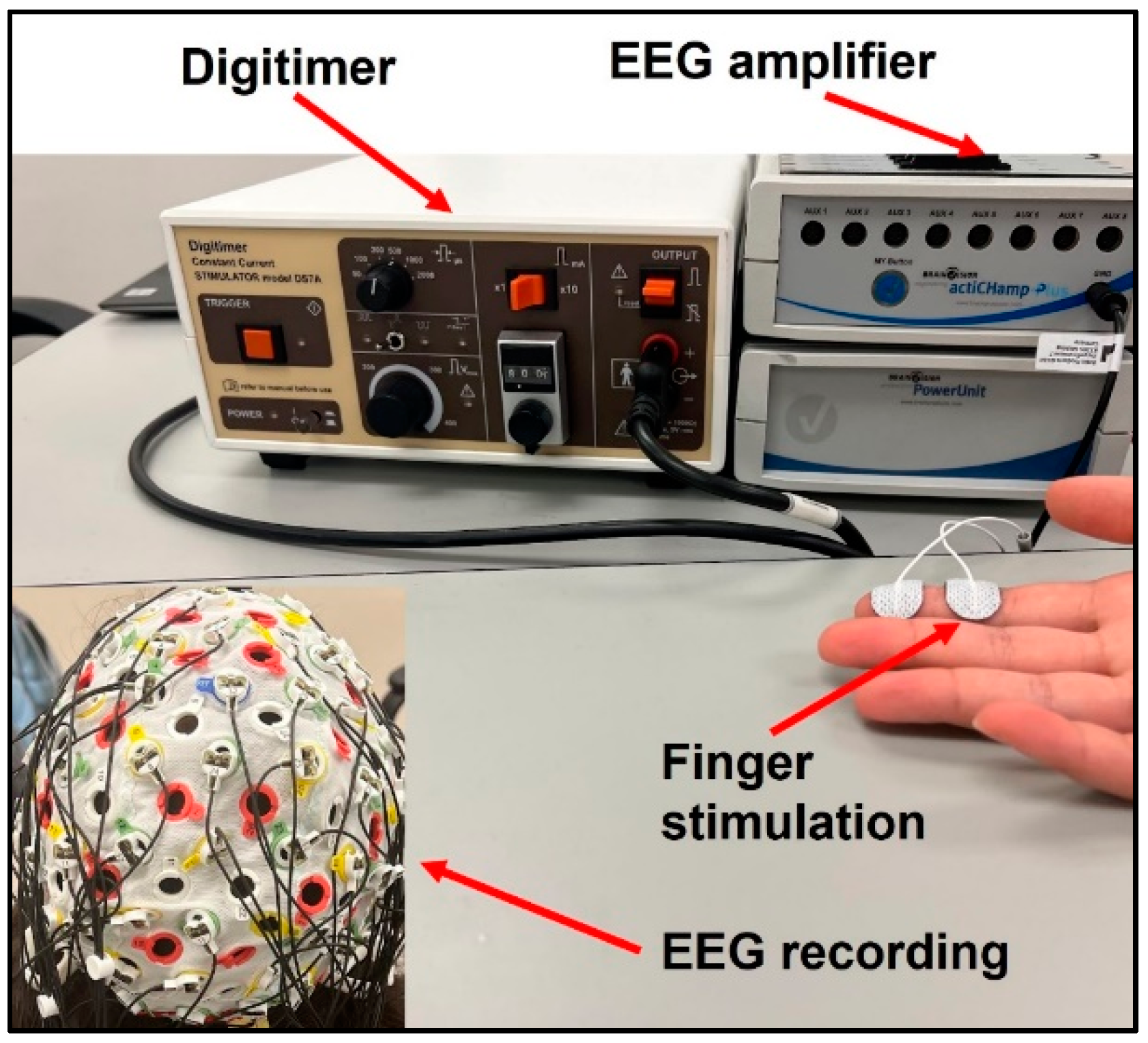
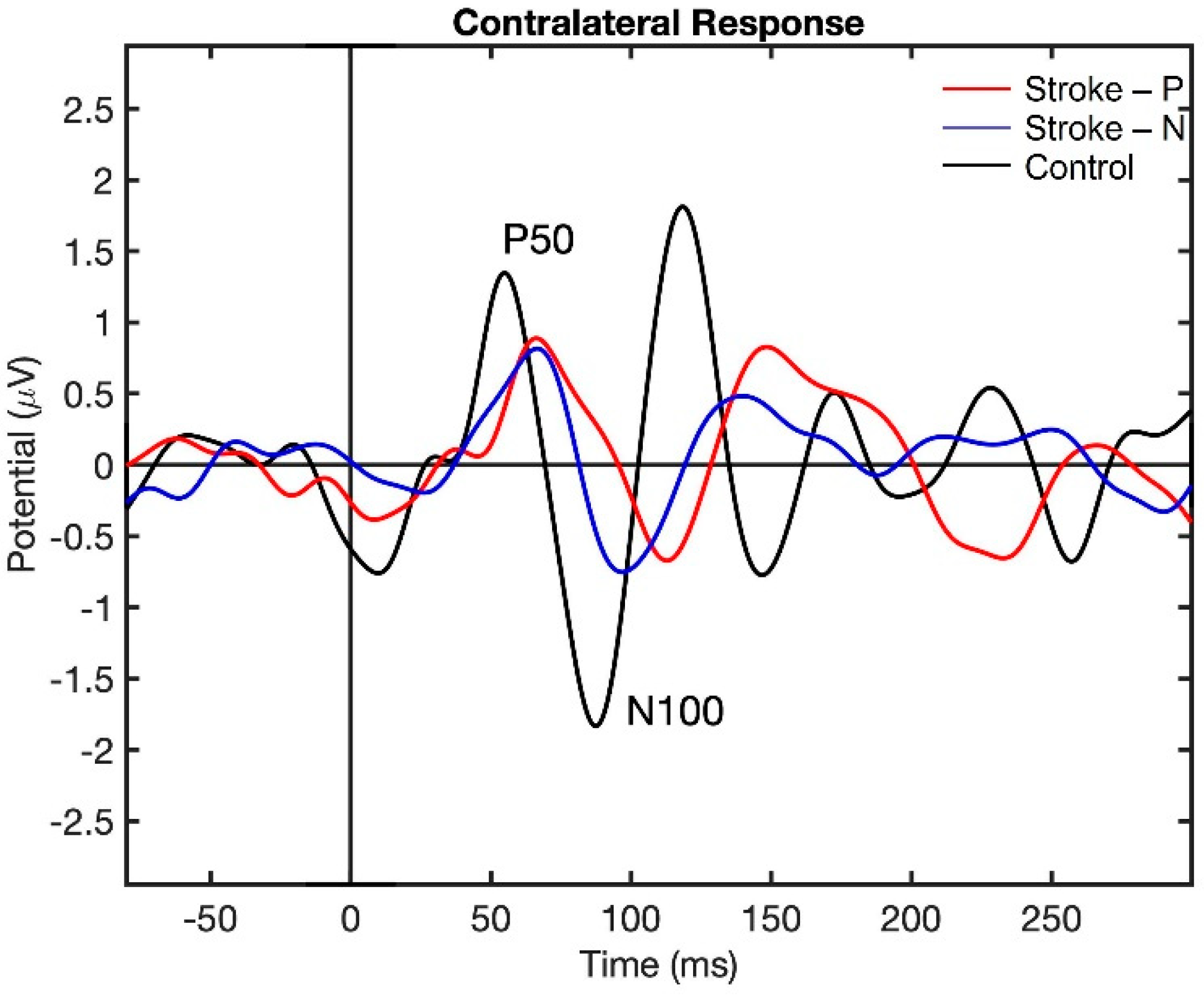
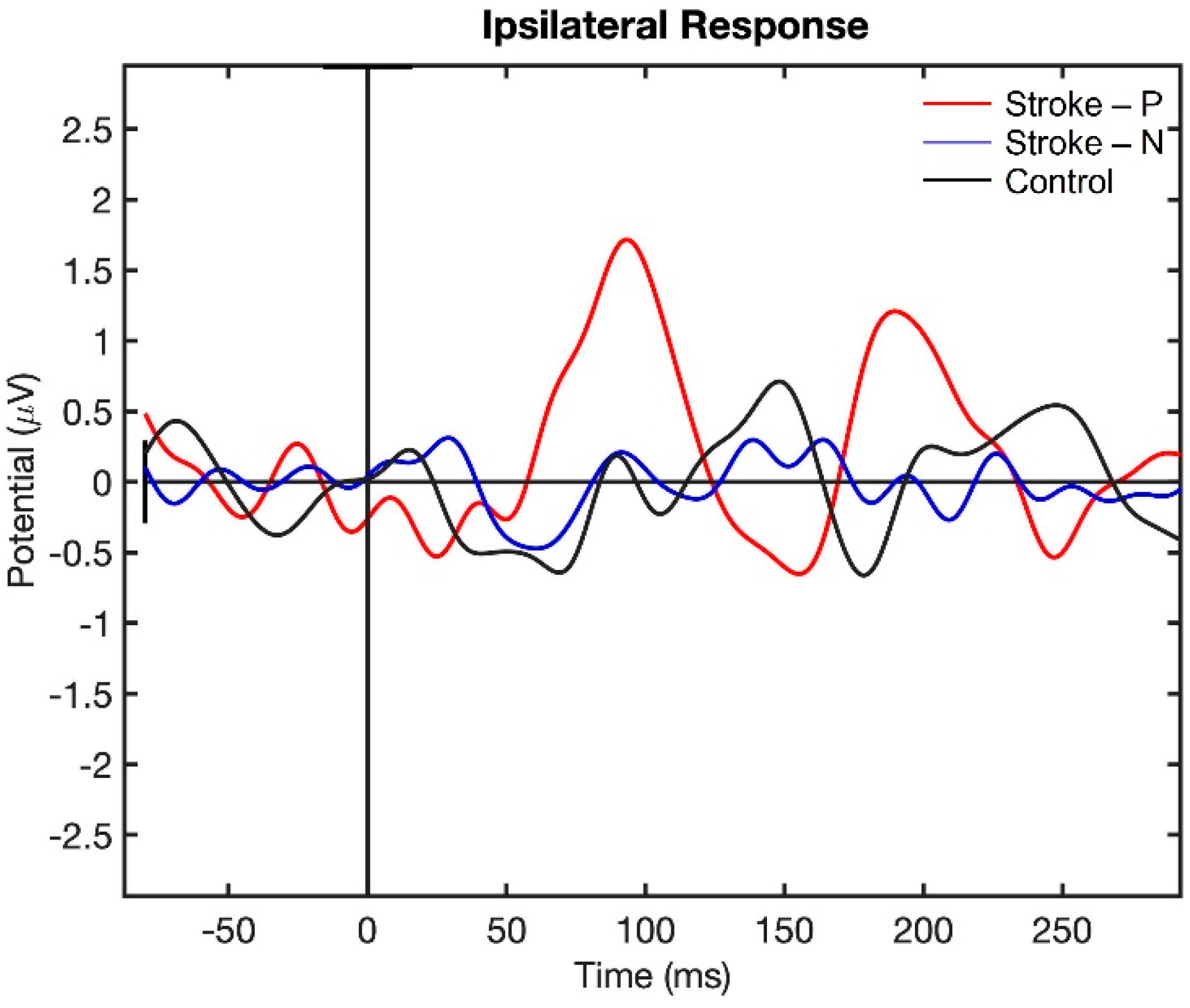
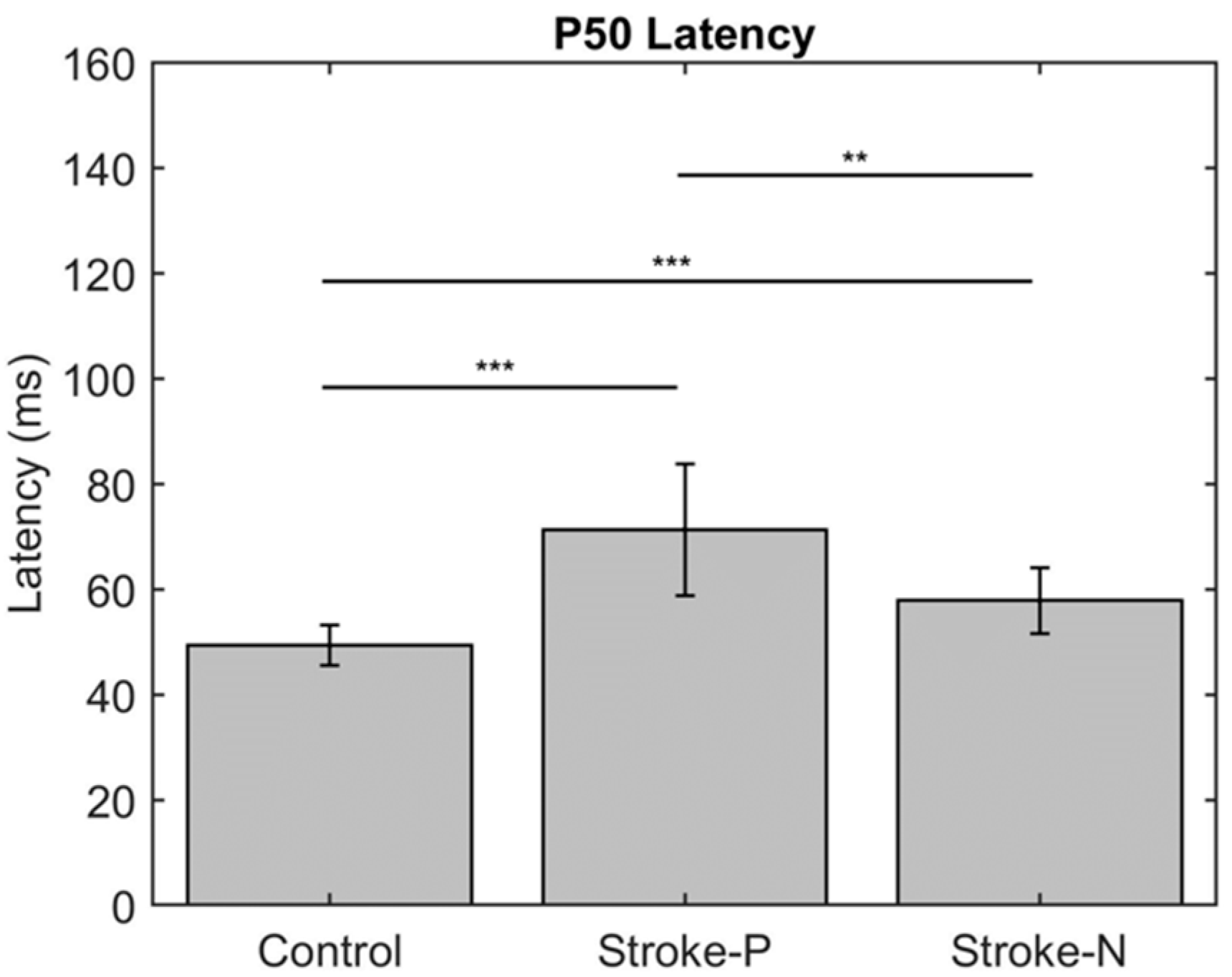
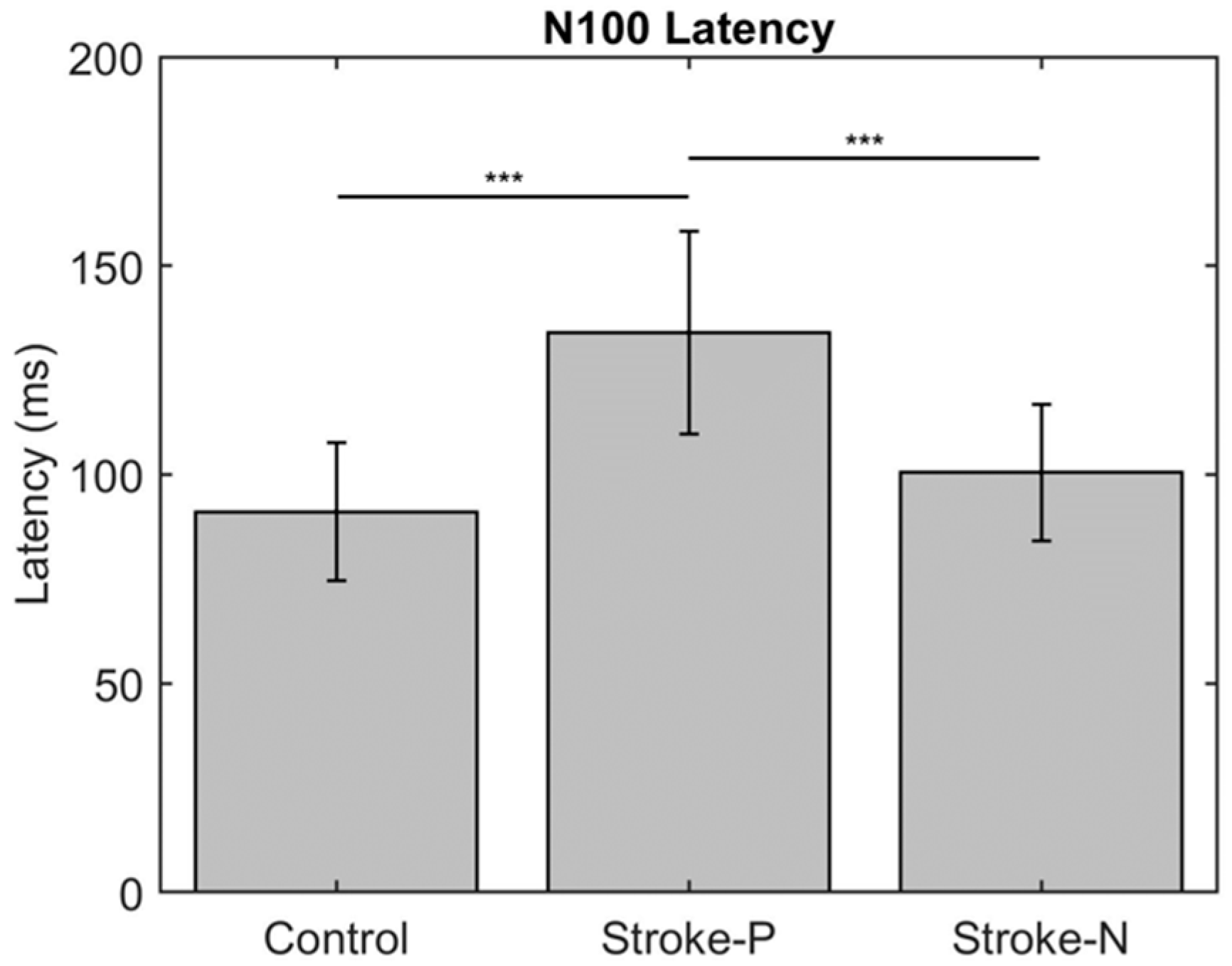
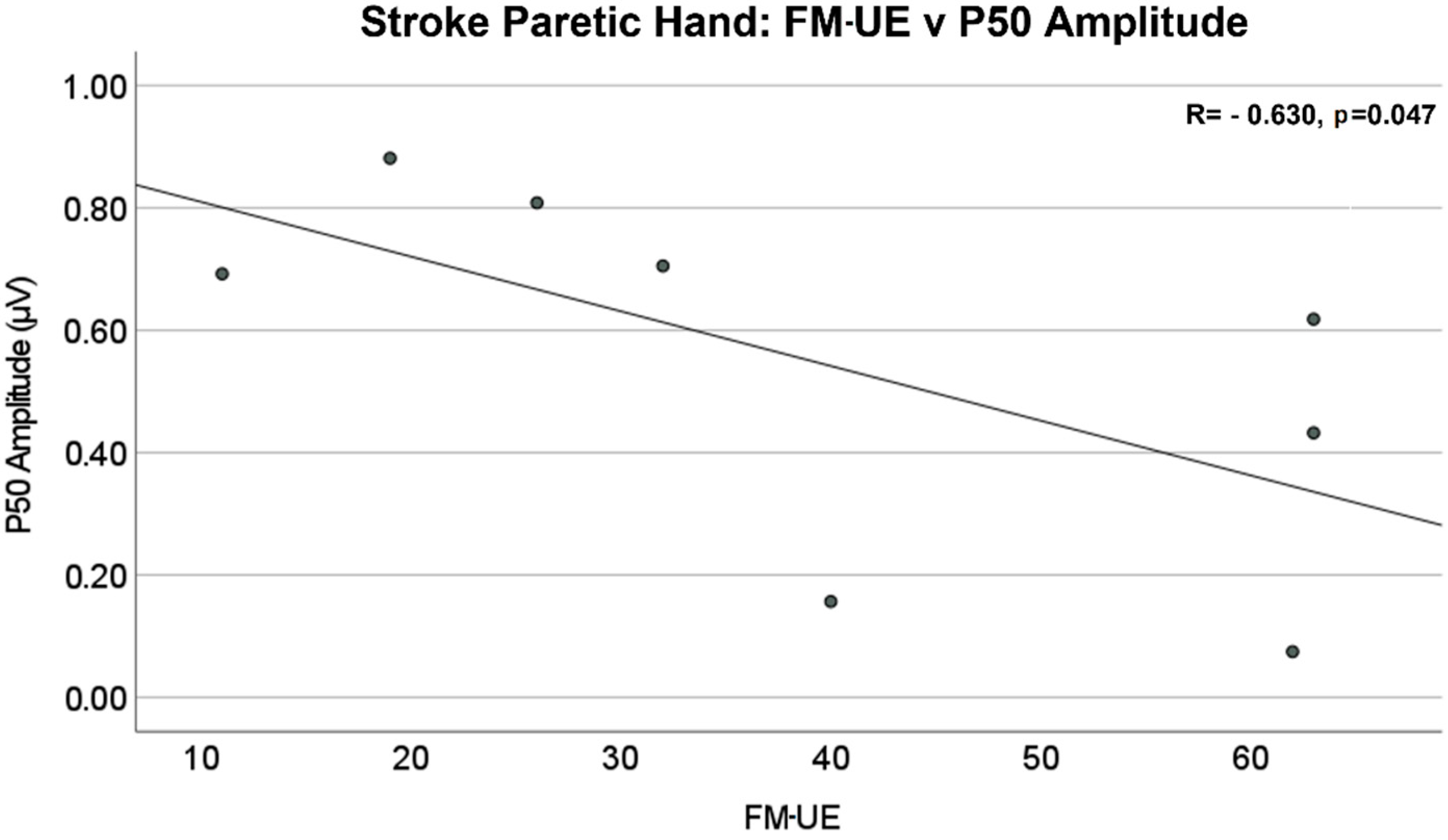
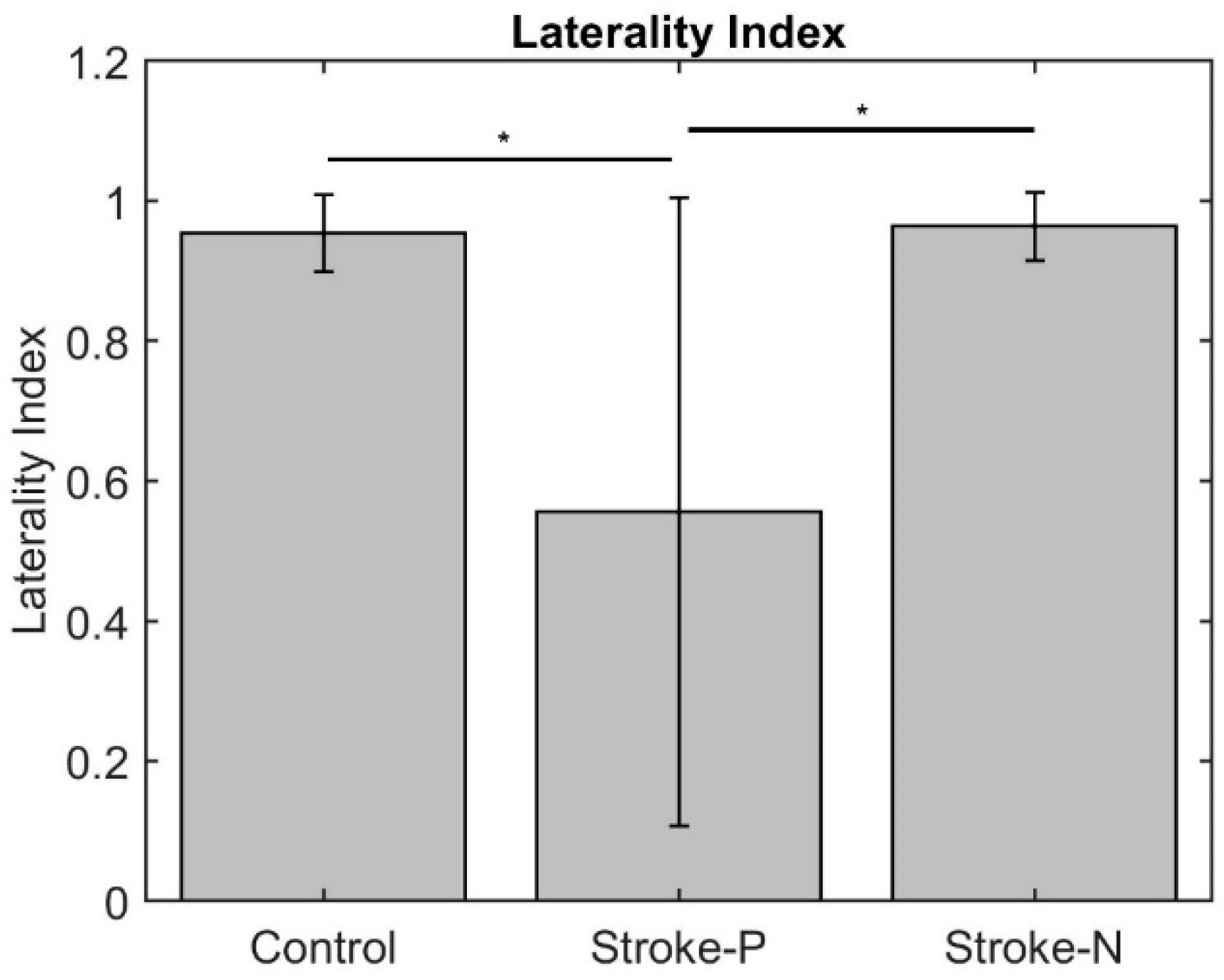
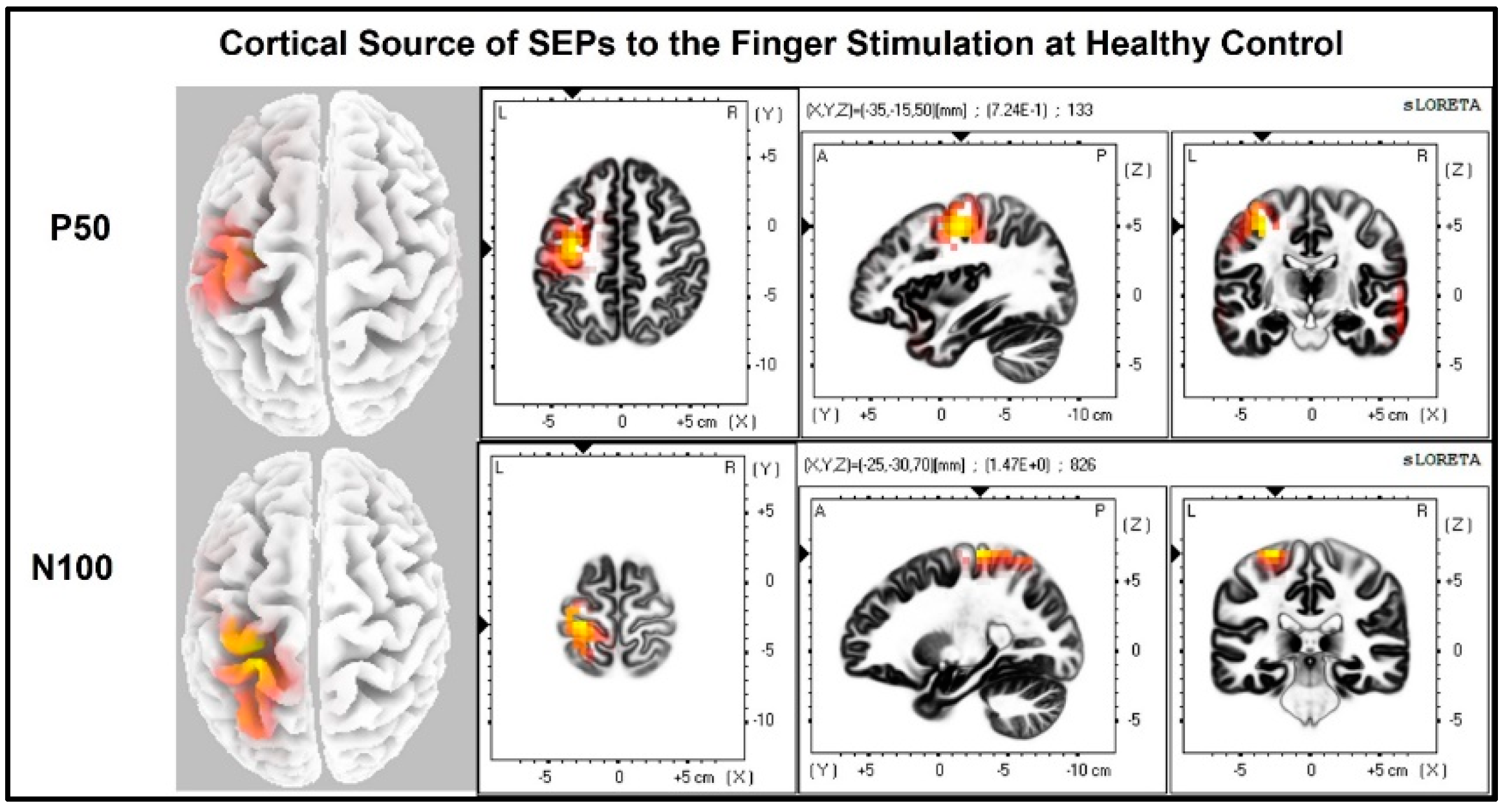
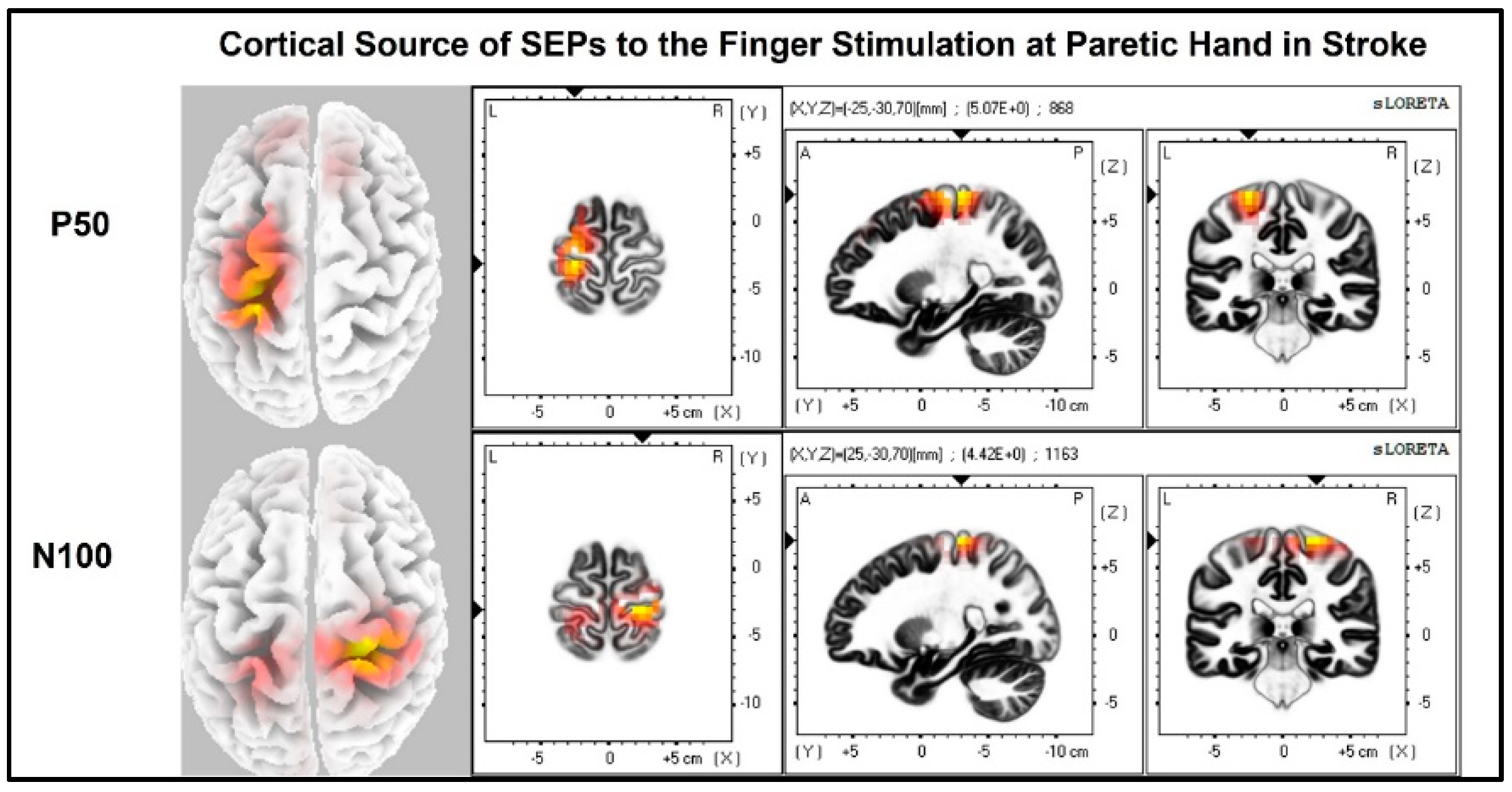
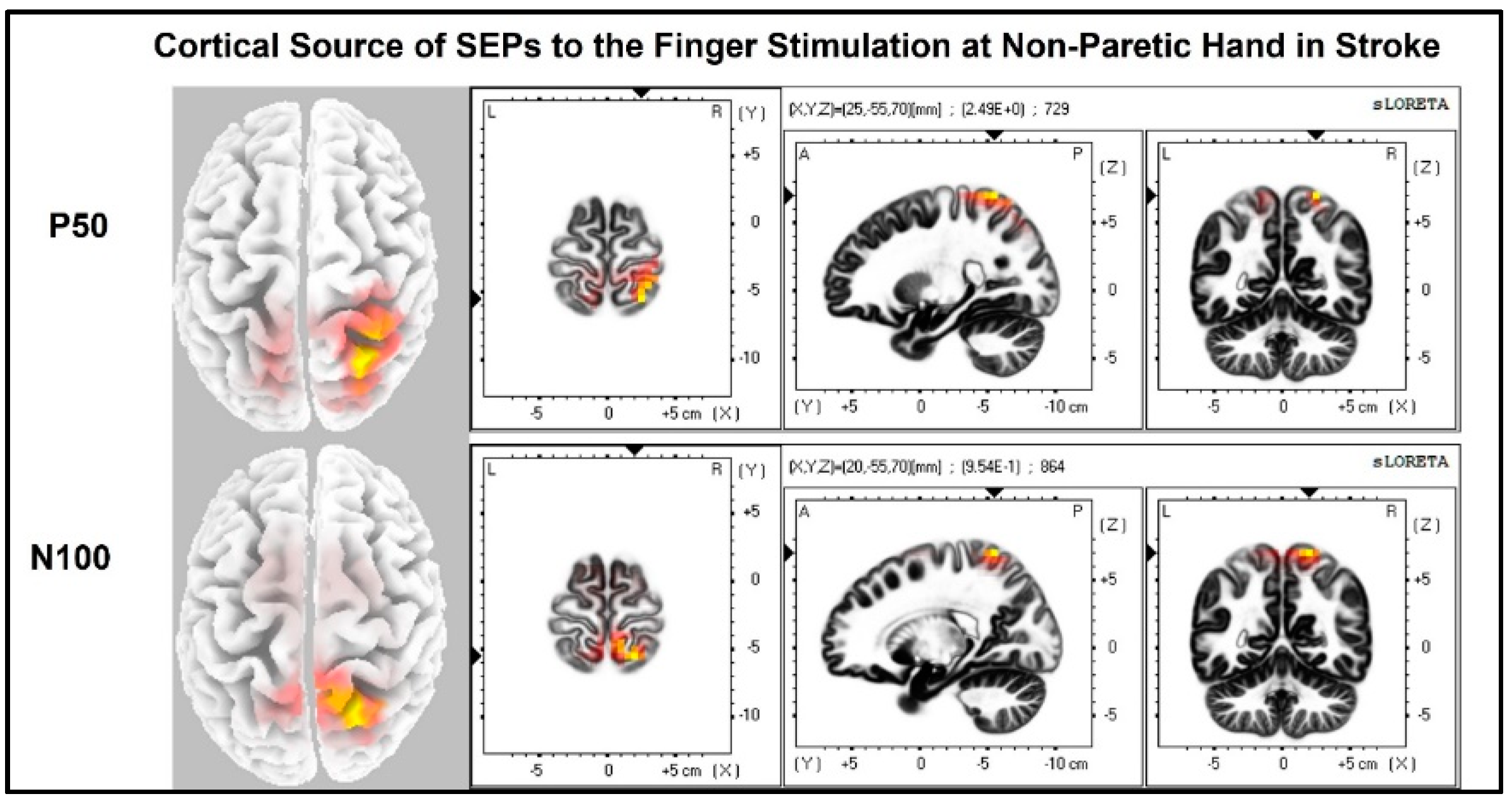
| Subject ID | Lesion Side | Paretic Hand | FM-UE (Total: 66) | Stroke Year |
|---|---|---|---|---|
| S001 | Right | Left | 6 | 2017 |
| S002 | Right | Left | 63 | 2019 |
| S003 | Left | Right | 11 | 2014 |
| S004 | Left | Right | 26 | 2019 |
| S005 | Left | Right | 63 | 2013 |
| S006 | Left | Right | 32 | 2021 |
| S007 | Right | Left | 40 | 2019 |
| S008 | Right | Left | 19 | 2021 |
| S009 | Left | Right | 62 | 2007 |
| Measure | Mean | Mean | 95% CL Lower | 95% CL Higher | Std | Min | Max | Median |
|---|---|---|---|---|---|---|---|---|
| Latency | ||||||||
| Latency—P50 | Stroke-P | 71.30 | 60.12 | 82.48 | 13.37 | 55.00 | 93.60 | 70.10 |
| Latency—P50 | Stroke-N | 57.51 | 52.46 | 62.57 | 6.58 | 51.40 | 67.00 | 54.00 |
| Latency—P50 | Control | 49.30 | 45.89 | 52.71 | 4.08 | 42.00 | 53.80 | 51.10 |
| Latency—N100 | Stroke-P | 134.30 | 112.63 | 155.97 | 25.92 | 87.00 | 158.00 | 149.20 |
| Latency—N100 | Stroke-N | 99.40 | 86.11 | 112.69 | 17.29 | 78.00 | 134.40 | 96.00 |
| Latency—N100 | Control | 91.13 | 76.38 | 105.87 | 17.64 | 72.00 | 119.00 | 85.80 |
| Amplitude (Amp) | ||||||||
| Amp—P50 | Stroke-P | 0.49 | 0.23 | 0.74 | 0.33 | 0.00 | 0.88 | 0.62 |
| Amp—P50 | Stroke-N | 0.75 | 0.49 | 1.00 | 0.33 | 0.31 | 1.25 | 0.69 |
| Amp—P50 | Control | 0.75 | 0.39 | 1.12 | 0.44 | 0.13 | 1.66 | 0.69 |
| Amp—N100 | Stroke-P | −0.69 | −1.26 | −0.12 | 0.74 | −2.28 | 0.00 | −0.39 |
| Amp—N100 | Stroke-N | −0.37 | −0.56 | −0.17 | 0.25 | −0.85 | −0.01 | −0.33 |
| Amp—N100 | Control | −0.43 | −0.84 | −0.02 | 0.49 | −1.28 | −0.00 | −0.20 |
| Laterality Index (LI) | ||||||||
| Mean LI | Stroke-P | 0.56 | 0.15 | 0.96 | 0.48 | −0.25 | 1.00 | 0.68 |
| Mean LI | Stroke-N | 0.93 | 0.81 | 1.04 | 0.15 | 0.54 | 1.00 | 0.98 |
| Mean LI | Control | 0.95 | 0.91 | 1.00 | 0.06 | 0.86 | 1.00 | 0.99 |
Publisher’s Note: MDPI stays neutral with regard to jurisdictional claims in published maps and institutional affiliations. |
© 2022 by the authors. Licensee MDPI, Basel, Switzerland. This article is an open access article distributed under the terms and conditions of the Creative Commons Attribution (CC BY) license (https://creativecommons.org/licenses/by/4.0/).
Share and Cite
Williamson, J.N.; Sikora, W.A.; James, S.A.; Parmar, N.J.; Lepak, L.V.; Cheema, C.F.; Refai, H.H.; Wu, D.H.; Sidorov, E.V.; Dewald, J.P.A.; et al. Cortical Reorganization of Early Somatosensory Processing in Hemiparetic Stroke. J. Clin. Med. 2022, 11, 6449. https://doi.org/10.3390/jcm11216449
Williamson JN, Sikora WA, James SA, Parmar NJ, Lepak LV, Cheema CF, Refai HH, Wu DH, Sidorov EV, Dewald JPA, et al. Cortical Reorganization of Early Somatosensory Processing in Hemiparetic Stroke. Journal of Clinical Medicine. 2022; 11(21):6449. https://doi.org/10.3390/jcm11216449
Chicago/Turabian StyleWilliamson, Jordan N., William A. Sikora, Shirley A. James, Nishaal J. Parmar, Louis V. Lepak, Carolyn F. Cheema, Hazem H. Refai, Dee H. Wu, Evgeny V. Sidorov, Julius P. A. Dewald, and et al. 2022. "Cortical Reorganization of Early Somatosensory Processing in Hemiparetic Stroke" Journal of Clinical Medicine 11, no. 21: 6449. https://doi.org/10.3390/jcm11216449
APA StyleWilliamson, J. N., Sikora, W. A., James, S. A., Parmar, N. J., Lepak, L. V., Cheema, C. F., Refai, H. H., Wu, D. H., Sidorov, E. V., Dewald, J. P. A., & Yang, Y. (2022). Cortical Reorganization of Early Somatosensory Processing in Hemiparetic Stroke. Journal of Clinical Medicine, 11(21), 6449. https://doi.org/10.3390/jcm11216449







